Why Internal Marketing Communication Matters for Your Business
Have you ever wondered why your employees don't seem as enthusiastic about your brand as your customers? Here's the secret weapon you might be missing: internal marketing communication.


Choose the right Internal Communication Software
Choosing the right internal communications software is a delicate process. Evaluate yourcommunication goals and needs, and select the right software with confidence using our Internal Communication Software Buyer’s Guide.
Access NowHave you ever wondered why your employees don't seem as enthusiastic about your brand as your customers? Here's the secret weapon you might be missing: internal marketing communication.
A multifaceted approach, internal marketing communication involves various channels, tactics, and strategies to communicate with employees. By adopting a comprehensive and integrated approach to internal marketing communication, organizations can create a positive and productive work environment, increase employee engagement, and drive business results.
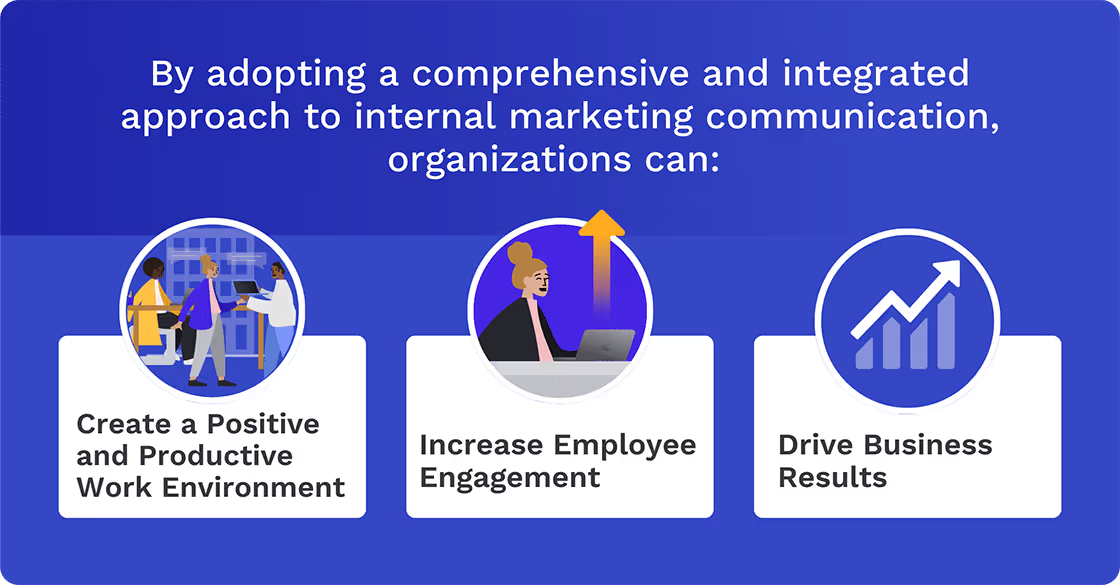
We’re going to discuss internal marketing communication and consider how it differs from external marketing communication. We’ll also consider why it is so important for your business. We have identified seven top strategies that you can adopt. With these in mind, you can consider and assess the best internal marketing communication tools to use to improve your organization’s internal communications.
By implementing a strategic and engaging internal marketing strategy, you can turn your employees into your biggest brand advocates, leading to a more successful and thriving business.
What is Internal Marketing Communication?
Gallagher’s State of the Sector 2023/24 report identifies organizational priorities for 2024. At 63%, the top priority is the need to engage teams on purpose, strategy, and values. While it was also named as the top priority in the 2022/23 report, 12% more respondents identified it as being most important this time.
This indicates, in part, what internal marketing communication is all about — the process of communicating with employees about the organization's goals, values, and initiatives. In essence, it depends on sharing information, updates, and news about the company with employees through various channels and mediums. It can take many forms, including:
- Company-wide emails or newsletters
- Intranet articles or blog posts
- Town hall meetings or town squares
- Video or audio content
- Social media groups or forums
- Printed materials such as posters, flyers, or brochures
- Digital signage or electronic displays
- Employee ambassadors or champions
- Change management initiatives
- Recognition and reward programs
However, it needs to be a two-way conversation that encourages employee participation, feedback, and input. This is important because it fosters a sense of ownership and accountability among employees, allowing them to feel invested in the organization's success and motivated to contribute to its growth and development. By encouraging employee participation, feedback, and input, internal marketing communications can help to build trust, increase job satisfaction, and drive business results.
It’s also important to realize that internal marketing communication isn't about selling products to your employees. It's about promoting your company's mission, vision, and values to your internal audience. More importantly, it's about making employees brand ambassadors who understand and embody what the company stands for.
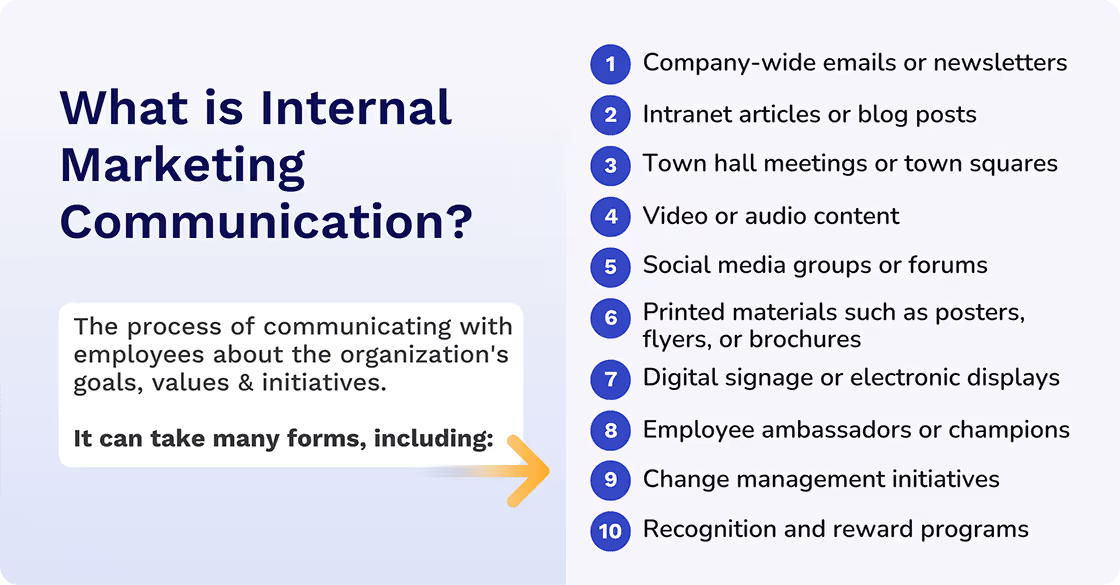
External vs Internal Marketing Communication
The key difference between external and internal marketing communication is that:
- External marketing communication focuses on attracting customers
- internal marketing communication focuses on engaging employees
While both are crucial, internal marketing communication often gets overlooked in favor of customer success strategies. Both are vital.
Free Internal Communications White Paper to Improve ROI
Turn your internal communications strategy around today

Download Free
Why is Internal Marketing Communication Important?
Here are many reasons why a strong internal marketing communication strategy is essential for any business. For example, it helps to build a positive company culture, increases employee engagement, and drives business results.
Perhaps surprisingly, it also enhances the customer experience. After all, employees who understand the brand can better represent it, leading to a more positive customer experience. Did you know that brand messages shared by employees can have a massive reach — much more than those posted by your official brand accounts? Stats in an article published by Forbes, Personal Branding And The New World Of Work written by personal branding pioneer, William Arruda, are worth noting. For instance:
- Brand messages can have a 561% greater reach when shared with employees vs the very same messages shared on official brand social channels.
- Brand messages are 24 times more likely to be re-shared when they come from employees rather than official brand channels.
Can it get better than that? Maybe it can! Here’s how.
Build a Positive Company Culture
Internal marketing communication helps employees understand the organization's mission, vision, and values, creating a sense of shared purpose and belonging. When everyone understands the brand message, it creates a unified front both internally and externally.
You can also use internal marketing communication to recognize and show appreciation for employee achievements, fostering a sense of pride and motivation.
Clear communication of goals, objectives, and expectations helps employees understand their role in achieving the organization's objectives. It can also empower employees by providing the information and resources they need to make informed decisions and take ownership of their work.
Additionally, a strong company culture built through internal marketing attracts and retains high-performing employees.
Increase Employee Engagement
Internal marketing communication is a proven tool to increase job satisfaction and improve internal communications. Apart from anything else, effective internal communication fosters a collaborative environment where employees feel empowered to share ideas.
Also, you will boost employee engagement simply because informed and enthusiastic employees are more productive and invested in a company's success.
An effective internal marketing strategy can improve internal communications between employees, departments, and different levels of the organization. It can increase job satisfaction by providing employees with a sense of purpose, recognition, and appreciation. Furthermore, transparency and authenticity lead to increased engagement and commitment, because a good internal marketing strategy increases trust.
Well-developed internal marketing communication can also encourage employee advocacy, where employees become ambassadors for the organization, promoting its values and mission.
Drive Business Success
One of the most valuable results of good internal marketing communication is that it can drive positive business outcomes. For example:
- Internal marketing communications can increase productivity by providing employees with the information and resources needed to perform their jobs effectively.
- Effective marketing communications within a company can facilitate collaboration and teamwork, leading to increased innovation and problem-solving.
- Internal marketing communications can enhance the employer brand, attracting top talent and increasing employee retention.
- It can also provide employees with the information needed to make informed decisions, leading to better decision-making and increased business results.
Internal Marketing Communication Examples
Before we tackle some of the winning strategies you can use for internal marketing communication, let’s look at a few creative ways to implement them. They are remarkably simple and can be amazingly effective.
- Consider welcoming new hires with a brand immersion program. Start out by educating them on the company's history, mission, and values.
- Create internal recognition programs and celebrate employee achievements and contributions to the brand.
- Develop employee advocacy programs that will empower employees to share positive brand experiences on social media.
- Organize company-wide employee engagement events to foster a sense of community and celebrate company milestones.
Top 7 Internal Marketing Communication Strategies
There are so many different internal marketing communication strategies that organizations can use. We’ve taken the pain out of selection and chosen our top seven for you to assess and try. Ideally, you’ll employ all of them for maximum impact and potential success.
Discover Your Internal Marketing Needs
There’s tons of work your team has to do to get your employee branding in a good place.
Before you set up any meetings outside your team or buy any swag with a tagline you might’ve thought up, answer these questions:
- What’s the purpose of your employee branding strategy?
- What goals does your team have for this project?
- What resources do you currently have?
- What is or isn’t working about your current resources?
- What is your team’s measurement for success for this employee branding project?
Answers to these questions will help to lay the foundation for your marketing undertaking. Only then should you launch into the brand identity discovery phase. The aim here is to learn more about your company’s culture and highlight any concerns by asking your stellar employees directly.
Your marketing team can share your brand’s mission, vision, and values with you. But the average employee sees them in a different light. Not only must you make sure your team is going in the right direction, but by talking to them upfront, you can build an “open door” reputation.
Free Internal Communications White Paper to Improve ROI
Turn your internal communications strategy around today

Download Free
Craft Employee-Led Focus Groups
There’s an art to crafting a good focus group experience. It starts with making a list of participants for a cross-functional and cross-generational supergroup.
Ideally, you’re looking for ten or fewer employees with unique perspectives to join the group. If you’re a member of a larger organization, you might want to run a few different rounds of groups on a regional or international level.
It’s essential to set the tone for the employee focus group before you start, with a strong emphasis on transparency. You can pull specific words and phrases directly from your employee focus group sessions that shape your tagline, values, and key messaging.
Here are some ideas to help you.
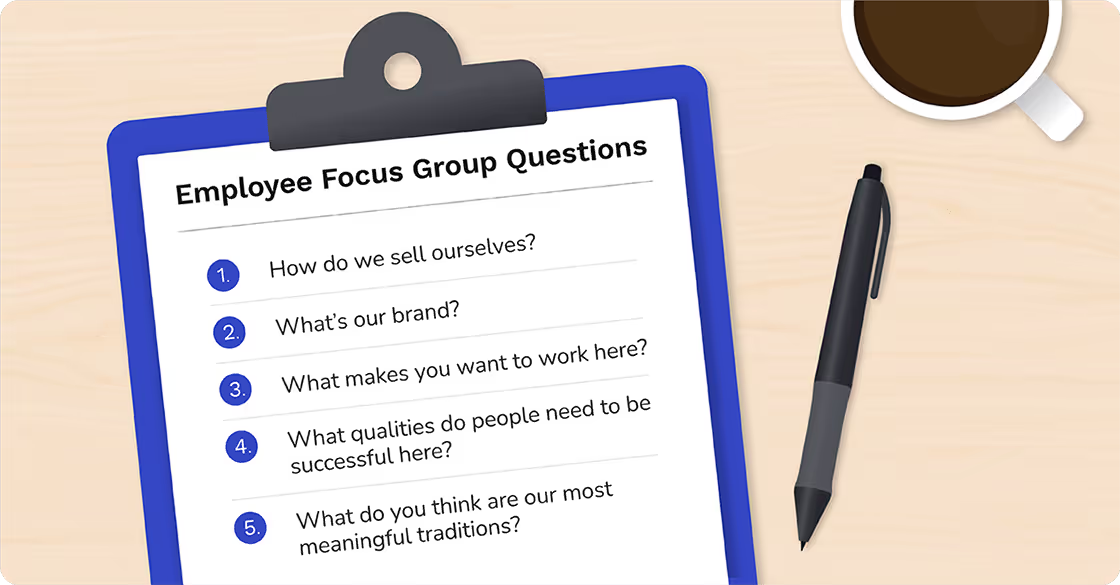
Align and Outline Company Cultural Values
Now, it’s time to change from top-down. Depending on the size of your organization, members joining your branding task force can vary from the CEO to your team lead. This is your chance to present your findings from the employee resource groups and core messaging your team wrote — ideally getting enthusiastic feedback from your higher-ups.
Involving leadership this early on in the process will establish one of your stellar employee brand ambassadors and ensure that your messaging stays connected.
Once you’ve crafted drafts for important employee branding elements like a belief statement and key messaging, it’s time to bring in some long-haul and green employees. It’s definitely the most difficult part of the process. Not necessarily because it’s challenging to craft, but because you’ll likely be overwhelmed with opinions.
This feedback isn’t about your grammar or word choice. It’s about ensuring that new and old employees are onboard and aligned with your foundation for the employee brand.
Ensure employee branding consistency and education
Once your team has its messaging ducks lined in a proverbial row, you need to ensure it’s solidified and accessible.
Working alongside your marketing, design, and/or branding teams, you need to confirm the extension of your brand with the correct gatekeepers. Things like colors, vocab, naming of conventions, and processes, must live under your company brand in a way that will last. Tools like an AI-powered logo generator can also support this effort by ensuring consistency in visual branding elements across departments."
Moving forward, posting these employee branding assets on an accessible platform like your intranet will help educate your employees and solidify your branding foundation.
Strategize Different EX Stages
There’s a vast messaging difference between someone you’re onboarding and someone who’s been with the company for a decade. Depending on the employee stage, the team’s collaboration, responsibilities, and processes will be unique.
That’s why our cultural team broke down Cerkl’s existing EX cycle into the following chart — to make it easier to tackle and develop each stage.
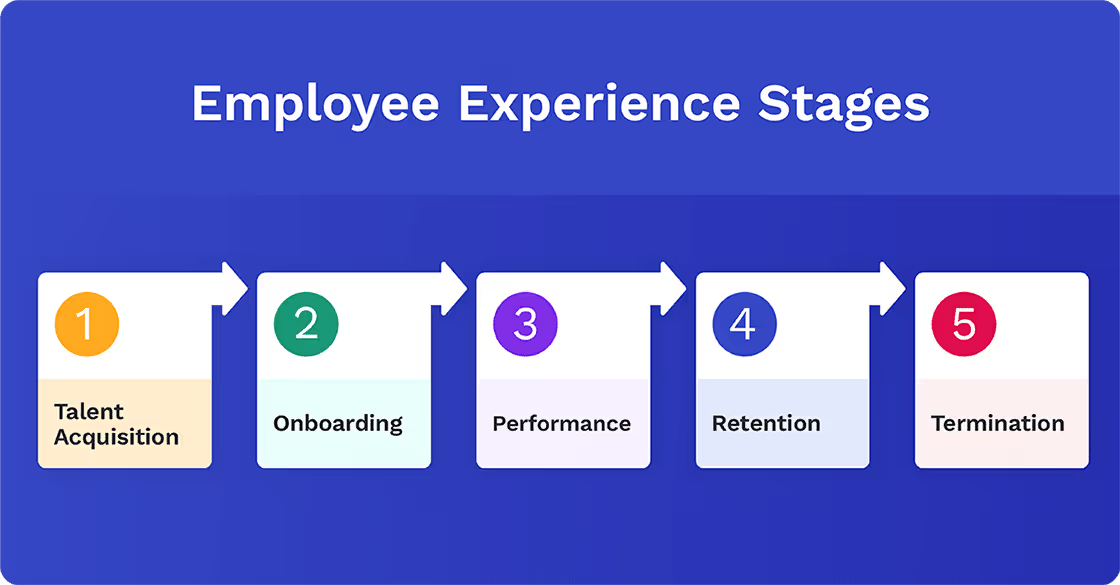
Launch Employee Channel Audit and Evaluate New Opportunities
Forget ideas for now, and take stock of what’s needed for each stage of an employee experience.
If your team is looking to launch a more employee-centric channel, a good one is culture Instagram. Instagram is a far more casual platform than LinkedIn. There’s not even a need for an official post. Over 500 million users post on their Instagram stories daily, so the likelihood that your organization is tagged increases.
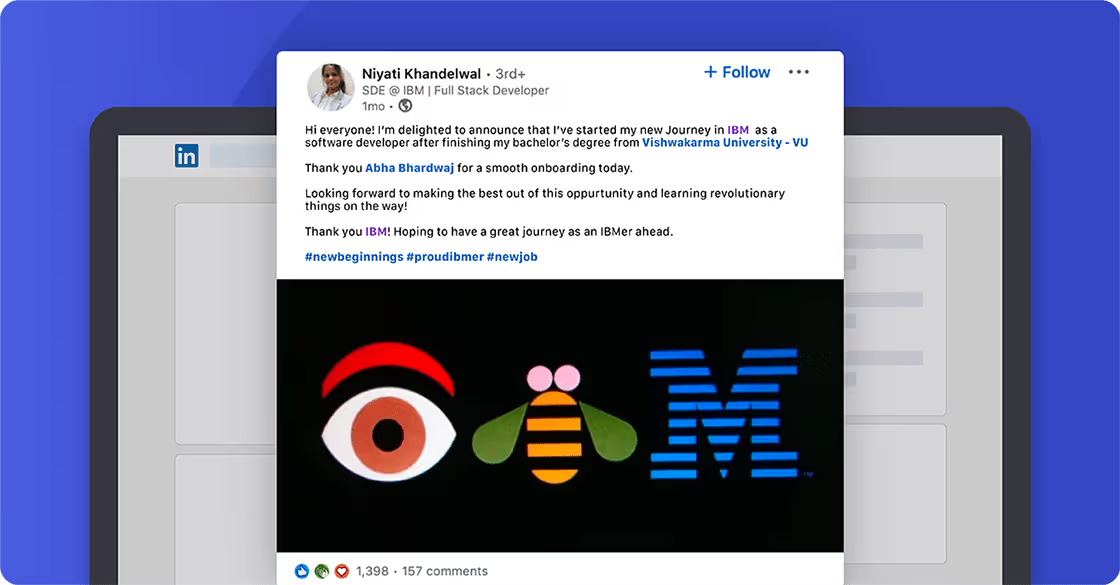
Using platforms like Glassdoor to showcase your employees’ opinions about their organization is a quick win for your department. The free Glassdoor plan has many benefits, such as responding to reviews, showcasing your mission, vision, values, and getting some basic analytics. But with the good also comes the bad. You’re going to get some people who think your organization and internal brand suck, and they want to share that opinion.
After you’ve figured out which channels you’ll be utilizing, it’s time to think through what media and art you’re going to need to whip out.
Map Out Your Employee Experience Marketing Collateral
It’s best to break this down into actionable phases when tackling a behemoth of a project like this one. By mapping your dream collateral to the stellar EX chart, it’s easier to prioritize and launch.
With businesses still embracing a hybrid or remote work approach, it’s essential to consider the “where” of work when thinking through different employee experiences.
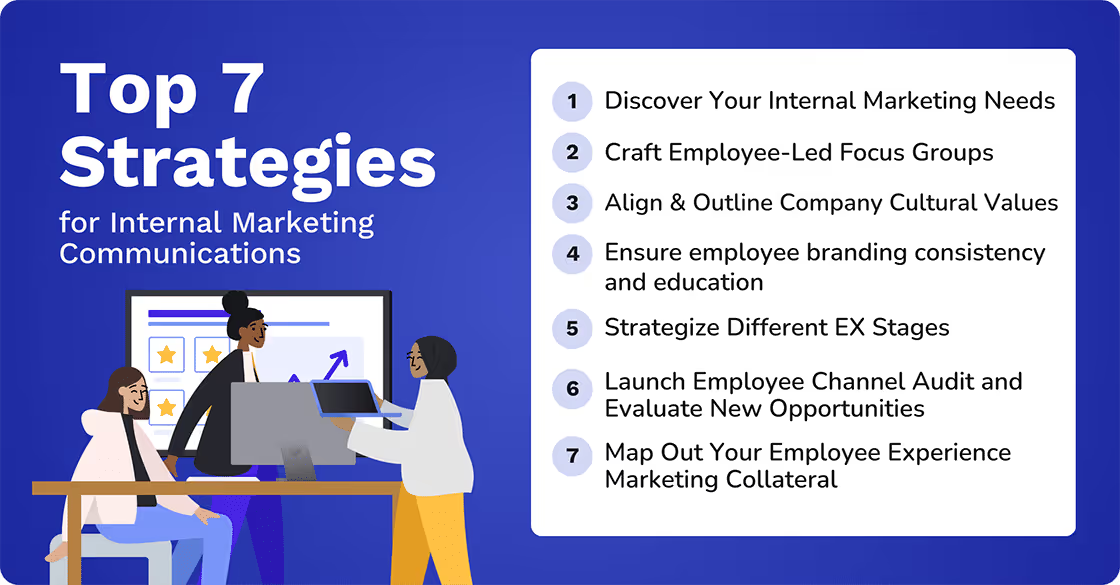
Internal marketing communication tools
There are various proven marketing tools you can use to communicate with your employees. However, choosing the right tool will depend on your specific needs. These include the size and structure of your company, the type of information you want to communicate, and your budget and resources. Bear in mind that it’s common to use a combination of these tools for a well-rounded internal communications strategy.
Note that our list includes both pros and cons.
Internal Email
Internal email is a classic and convenient way to share company news and updates. It's familiar, accessible on all devices, and great for targeted communication. When you use a platform like Cerkl Broadcast, you can also segment emails for different departments or roles.
Just remember that inboxes can get cluttered. This means that information overload is a risk, and long emails might get skimmed or ignored.
Employee Newsletters
Regular newsletters can keep employees informed about ongoing projects and achievements. They allow for creative and engaging content, including visuals and videos, and are good for company-wide announcements and updates.
However, frequency needs to be strategic - ie not too often or infrequent. Also, we all know that content creation takes time, and there is generally low interactivity compared to other tools.
Employee Communication Software
Platforms dedicated to internal communications offer features like polls, discussions, and recognition tools that promote employee engagement. They can also be a central hub for company news, announcements, and discussions. Many offer integrations with other work tools.
Be aware that cost can be a factor, requires some level of user adoption and training, and may replace existing communication methods some employees prefer.
Company Intranet
A company intranet is a centralized online hub for storing company documents, policies, and resources. It is also a good medium to use for announcements.
While it can be customized for different departments or teams, a company intranet can become cluttered and overwhelming if not well-organized. Generally, it requires ongoing maintenance to keep content fresh and relevant.
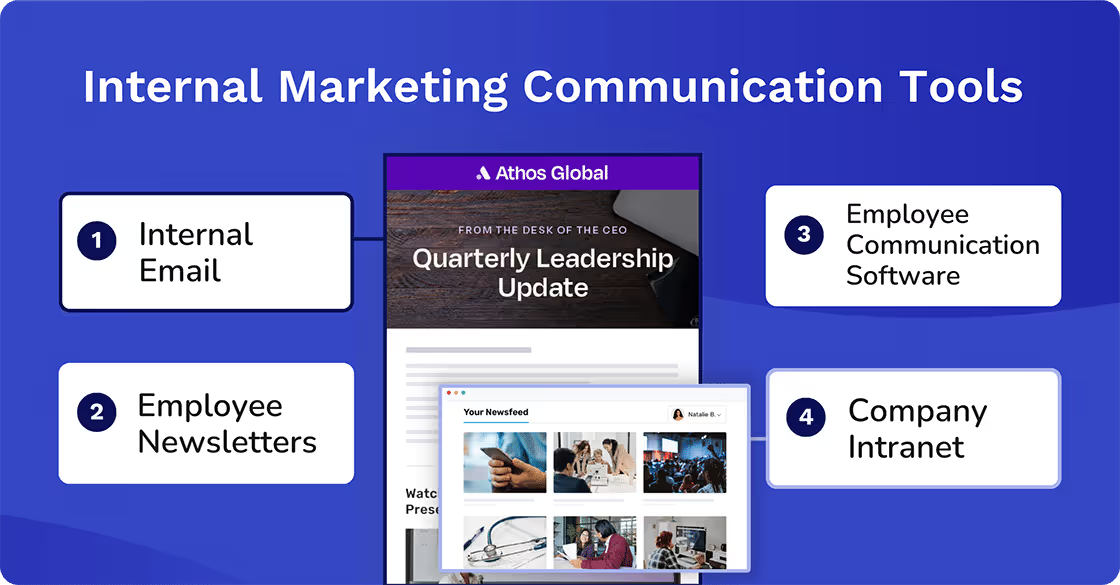
How Can Cerkl Help to Improve Your Internal Communication?
Cerkl Broadcast is an employee communication platform that helps organizations improve their internal communications by providing a centralized and engaging way to share information with employees. It provides a centralized platform for company news, announcements, and updates, making it easy for employees to stay informed and engaged.
Broadcast allows organizations to create personalized content for employees, tailoring the information to their interests and needs. It also enables real-time updates and notifications, ensuring that employees receive the latest information as soon as it's available.
Cerkl Broadcast enables you to encourage employee engagement through features like polls, quizzes, and gamification, making it a fun and interactive way to communicate.
Importantly, it provides analytics and insights on employee engagement and feedback, helping organizations understand what works and what doesn't.
A hugely valuable feature is that Cerkl Broadcast is customizable and can be integrated with existing tools and platforms, making it easy to incorporate into existing workflows.
What’s Next?
We’ve been discussing why internal marketing communication matters for your business. Maybe you’d like to explore further. We have a free resource for you, The Importance of Internal Communication. Have a look and then, if you’d like to chat, we’re here waiting for you.

Free Internal Communications White Paper to Improve ROI
Turn your internal communications strategy around today
Download Free
FAQ
What is internal marketing communications? Internal marketing communication is the process of communicating with employees about an organization’s goals, values, and initiatives in an effort to engage and motivate them. Effective internal marketing communications help to build a positive company culture, increase employee engagement, drive business results, and improve the overall EX.
What are examples of internal marketing? Examples of internal marketing include company-wide emails, intranet articles, town hall meetings, employee newsletters, and social media groups. These channels enable leadership to share company news, recognize employee achievements, and promote company initiatives to engage employees and foster a sense of community.
What is the best way to communicate internal marketing?The best way to communicate internal marketing is through a combination of digital and face-to-face channels. This can include using digital platforms such as intranets, email, and social media to share information, and hosting town hall meetings, town squares, and other face-to-face events to encourage employee engagement and feedback.









